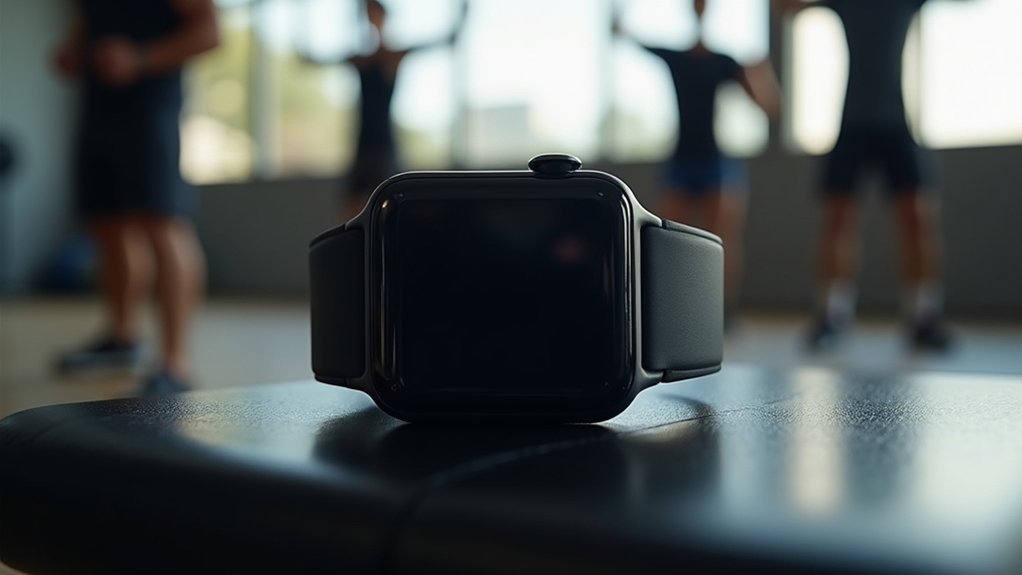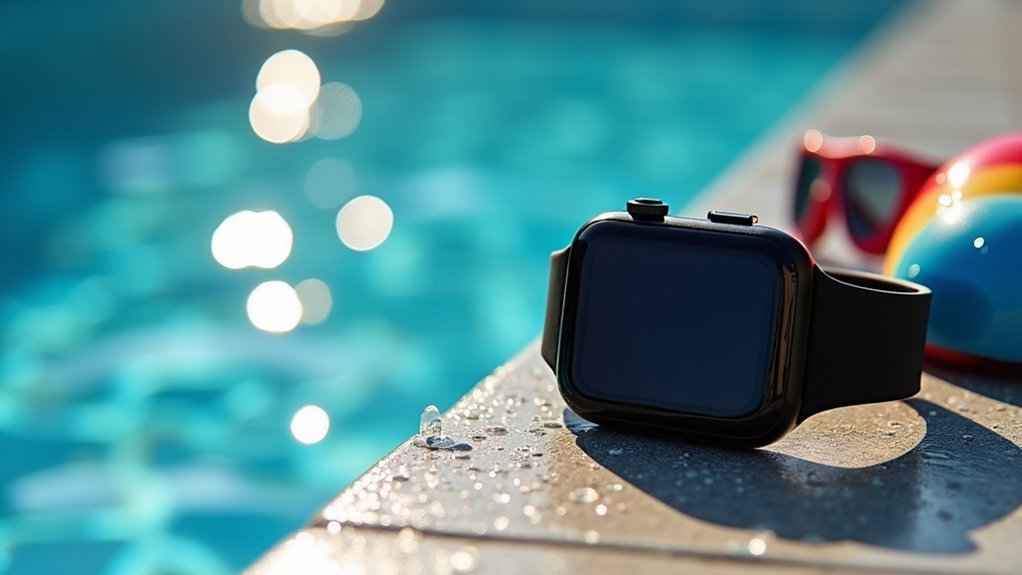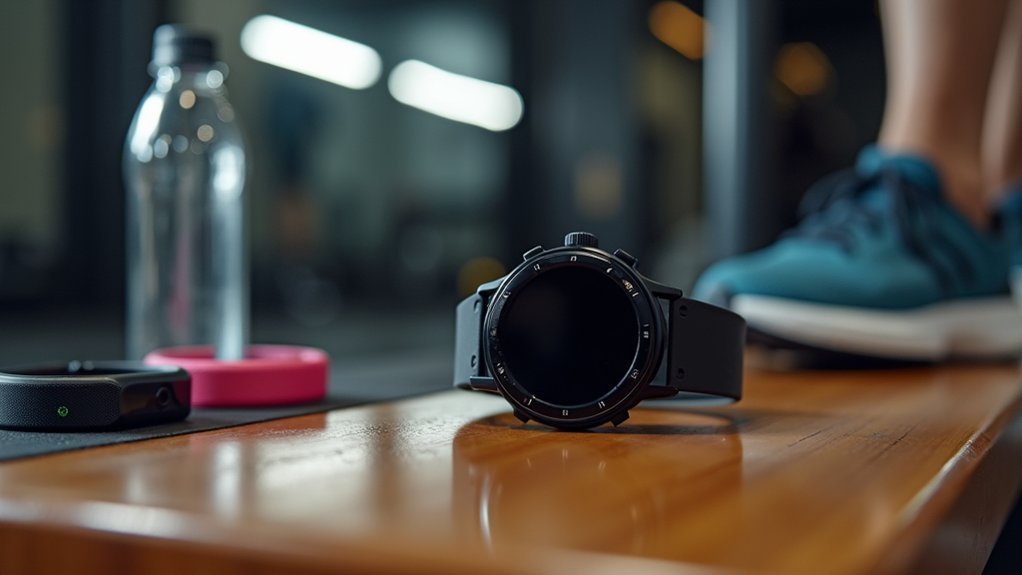For accurate heart zone training, chest strap monitors like the Polar H10 and Garmin HRM Pro Plus offer superior precision (99.6% accuracy), while wrist-based options provide convenience with acceptable error margins (+/- 3%). Premium devices track advanced metrics like VO2 max, while budget options like the Polar H9 focus on core functionality. Waterproof models with 5ATM ratings work well for swimmers. Your choice should balance accuracy needs against comfort for your specific training goals.
Understanding Heart Rate Zone Training Benefits

While many fitness enthusiasts simply focus on workout duration, understanding heart rate zone training can revolutionize your exercise effectiveness.
By targeting specific heart rate zones, you’ll optimize your workouts for particular physiological benefits, from fat burning to performance enhancement.
Training in appropriate zones helps you avoid overtraining while maximizing results. Zone 1 supports recovery, while Zone 2 builds endurance and metabolic health.
Smart training means knowing when to push and when to recover—your heart rate zones are the ultimate personalized guide.
When you push into Zones 3 and 4, you’ll increase your VO2max and aerobic capacity. Zone 5 training, reserved for maximum effort, prepares you for competitive performance.
Beyond improved athletic performance, zone training enhances your cardiovascular health, increases cardiac output, and provides structure to your fitness routine. Each person’s training zones are uniquely individual based on factors like fitness level, age, and genetics.
With today’s wearable technology, you can easily monitor your zones in real-time, making this powerful approach accessible to everyone.
Chest Strap Monitors vs. Wrist-Based Heart Rate Tracking
Heart rate monitoring technology comes in two primary forms: chest straps and wrist-based devices.
Chest straps use ECG technology to directly measure electrical signals from your heart, offering superior accuracy (99.6%) even during intense workouts. They’re reliable across various activities but can feel bulky and less comfortable during extended wear.
Wrist-based monitors use optical sensors that are more convenient and often integrated into stylish smartwatches with multiple functions. Research from Fuller et al. found most modern devices maintain acceptable measurement errors within +/- 3% during normal use.
However, they sacrifice accuracy for comfort, especially during high-intensity exercise when movement can disrupt readings.
Your choice ultimately depends on your priorities. If you need precise heart zone data for serious training, choose a chest strap.
If convenience and everyday wearability matter more, a wrist-based monitor will serve you well despite occasional accuracy limitations.
Premium Heart Rate Monitors for Elite Athletes

If you’re competing at elite levels, you’ll need top-tier heart rate monitors that deliver thorough performance metrics beyond basic readings.
Premium models from brands like Garmin and Polar offer advanced analytics including lactate threshold, VO2 max, and recovery assessments that help optimize your training regimen.
These high-end monitors also feature specialized multi-sport capabilities that seamlessly shift between swimming, cycling, and running while maintaining accuracy and connectivity to your preferred devices. For those seeking maximum precision, models with chest strap monitors provide the highest level of accuracy through direct electrode contact with the skin.
Elite Performance Tracking
The pursuit of excellence in elite athletics demands precision tools that deliver flawless data. For uncompromising performance metrics, the Garmin HRM Pro Plus captures advanced running dynamics with onboard memory and accelerometers, while the Polar H10 remains the gold standard for heart rate accuracy.
| Device | Key Elite Feature | Best For |
|---|---|---|
| Polar H10 | Gold standard accuracy | Precision training |
| Garmin HRM Pro Plus | Advanced running metrics | Multi-sport athletes |
| 4iiii Viiiiva | Smart trainer bridge | Indoor cycling |
| COROS HRM | Triple device connectivity | Team environments |
When training at the highest levels, you’ll appreciate the Polar H10’s third electrode and secure silicone grip, which virtually eliminates data drop during intense sessions. The 4iiii Viiiiva’s ability to bridge ANT+ devices to Bluetooth apps creates seamless data integration for thorough performance analysis. For athletes seeking affordability without sacrificing quality, the Garmin HRM 200 offers accurate heart rate monitoring at a more accessible price point.
Multi-Sport Monitoring Solutions
Elite athletes excel across multiple disciplines, demanding heart rate monitors that seamlessly travel from pool to trail to gym.
Devices like the Polar H10 and Garmin HRM-Pro deliver this versatility with superior accuracy and consistent signals that outperform wrist-based alternatives.
You’ll benefit from multi-device connectivity (Bluetooth and ANT+) that integrates with various sports watches, bike computers, and training apps.
Premium chest straps offer waterproof construction for swimming workouts while capturing advanced metrics beyond heart rate—including ground contact time, cadence, and vertical oscillation.
Look for comfortable, adjustable straps with breathable materials that won’t chafe during extended sessions.
The best models provide 20+ hours of battery life and automatic syncing with platforms like Strava and TrainingPeaks, ensuring your performance data follows you across all sporting environments.
For serious training assessments, many elite athletes prefer devices that use ECG readings rather than optical sensors due to their superior precision during high-intensity activities.
Budget-Friendly Heart Rate Wearables That Deliver Results
Finding affordable heart rate monitors doesn’t mean compromising on quality or performance. The Polar H9 stands out as an excellent entry-level option, offering accurate heart rate tracking at the lowest price point among chest straps. Its easy-to-adjust strap and tool-free battery replacement enhance user convenience.
For slightly more, the Garmin HRM Dual delivers impressive 1,000+ hour battery life and reliable accuracy. Both monitors feature Bluetooth and ANT+ connectivity, allowing you to pair simultaneously with multiple devices and over 200 fitness apps.
What makes these budget options smart choices is their focus on core functionality without unnecessary extras. Their machine-washable straps guarantee durability and hygiene for long-term use. For those seeking wrist-based alternatives, the Xiaomi Mi Smart Band 7 offers exceptional value for money with heart rate tracking and over 110 workout modes.
Despite their affordability, you’ll get precise heart rate data to optimize your training zones effectively.
Waterproof Options for Swimmers and Water Sports Enthusiasts

For swimmers and water enthusiasts, specialized waterproof heart rate monitors offer uncompromised performance beneath the surface.
Models like the Polar Verity Sense with its goggle clip attachment and the Garmin HRM-Swim with sticky silicone backing guarantee you’ll get reliable readings throughout your aquatic workouts.
You’ll find these underwater precision trackers maintain impressive accuracy—with devices like the FORM Smart Swim 2 Goggles achieving 97% accuracy compared to medical-grade ECG monitors.
Chest strap monitors provide more reliable data during swimming activities since they’re less affected by water movement compared to wrist-based optical sensors.
Underwater Precision Trackers
Serious swimmers and water sports enthusiasts require specialized wearable technology that can withstand the unique challenges of aquatic environments.
The best underwater trackers offer 5ATM water resistance (50m depth) and automatically recognize different swimming strokes for accurate performance analysis.
Look for devices with GPS capabilities if you’re into open-water swimming. While not all trackers include built-in heart rate monitoring, many offer compatible chest straps for thorough data collection.
Today’s top models like the Garmin Swim provide detailed metrics on distance, pace, and stroke efficiency, while FORM Smart Swim Goggles display real-time data directly in your field of vision.
When selecting your tracker, consider waterproof rating, stroke detection accuracy, and whether you need multi-sport compatibility for activities beyond the pool. Advanced trackers also calculate SWOLF score to help swimmers improve their technique and efficiency in the water.
Pool-Safe Monitoring Devices
The evolution of pool-safe monitoring devices has transformed how swimmers track performance in aquatic environments.
When selecting a wearable for pool workouts, look for at least a 5ATM waterproof rating, ensuring safe submersion up to 50 meters for typical swimming activities.
Top devices like FORM Swim Goggles display real-time metrics directly in your field of vision, while Apple Watch Series 8 and Garmin Swim 2 offer extensive tracking for both pool and open-water swimming. For optimal visibility, FINIS Smart Goggles position metrics to the side ensuring an unobstructed forward view during swims.
Budget-conscious swimmers can consider the Xiaomi Mi Smart Band 7.
The most effective pool wearables feature stroke recognition, SWOLF scoring for efficiency analysis, and heart rate monitoring during swims.
For triathletes, choose devices with multi-sport capabilities that shift seamlessly from water to land activities.
Battery Life Comparison of Top Heart Rate Monitors
Battery life metrics stand out as a critical factor when selecting the ideal heart rate monitor for your fitness regimen.
The Garmin HRM Dual leads with an impressive 3.5-year battery life or over 1,000 hours of training time, though replacing its battery can be challenging due to tiny screws.
If you prefer rechargeable options, the Polar Verity Sense offers 30 hours of training time per USB charge.
While the Garmin HRM Pro also boasts extended battery life, specific duration isn’t clearly detailed in available data.
The Wahoo TRACKR offers an excellent middle ground with its 100-hour rechargeable battery that supports multiple Bluetooth connections simultaneously.
Remember that your usage patterns greatly impact longevity—frequent training sessions will drain batteries faster.
When choosing between models, consider whether you’d prefer the convenience of USB recharging or the set-it-and-forget-it advantage of longer-lasting replaceable batteries like the HRM Dual’s.
Data Accuracy During High-Intensity Interval Training
When exploring fitness wearables, accuracy becomes particularly challenging during high-intensity interval training (HIIT). While wrist-worn devices perform admirably during steady-state cardio, their reliability plummets during intense workouts—dropping from 92% to as low as 35% accuracy compared to chest straps. These devices typically have a +/- 3% error when measuring heart rate under ideal conditions.
For ideal heart rate monitoring during HIIT, remember:
- Expect decreased accuracy when your heart rate exceeds 150 bpm, as most wearables struggle with rapid shifts.
- Position matters—left vs. right wrist placement shows statistically significant differences in error rates.
- Select the proper exercise mode on your device to improve tracking precision.
- Consider a chest strap monitor for critical heart zone training, as wrist devices show up to 20% error margins during high-intensity activities.
Best Wearables for Multi-Sport Heart Rate Tracking
Multi-sport athletes require heart rate monitors that can seamlessly shift between activities while maintaining accuracy across different environments.
The Polar H10 stands out with its exceptional versatility and gold-standard accuracy for cycling, running, and triathlon training, plus an impressive 400-hour battery life.
Garmin offers two compelling options: the HRM-Pro Plus delivers extensive running dynamics like stride length and cadence, while the HRM Dual provides excellent Heart Rate Variability measurements with extended battery performance.
Both support concurrent ANT+ and Bluetooth connections.
For athletes seeking simplified connectivity, Wahoo’s Tickr features an improved design with a rechargeable battery, while the 4iiii Viiiiva uniquely bridges connections between devices, freeing up valuable Bluetooth channels during multi-device training sessions. Regular strap cleaning is essential for preventing skin irritation and maintaining hygiene during intense multi-sport activities.
Maximizing Recovery With Heart Rate Variability Features
Heart rate variability monitoring represents a revolution in recovery optimization for athletes at all levels.
HRV monitoring gives athletes unprecedented insight into recovery status, transforming how we optimize training and prevent overtraining.
Unlike standard heart rate tracking, HRV offers deeper insights into your autonomic nervous system balance, providing earlier warning signs of stress and recovery status than resting heart rate alone.
To leverage HRV effectively with wearables:
- Measure your HRV consistently each morning to establish personal baselines and track recovery trends.
- Watch for significant drops in HRV as signals to adjust training intensity or incorporate additional rest.
- Pair HRV data with subjective wellness metrics for a more complete recovery picture.
- Use HRV patterns to personalize your training schedule, optimizing when to push harder and when to focus on recovery.
Scientific research indicates that reduced HRV is commonly observed for 24 hours after high-intensity strength training, with levels typically returning to baseline after 72 hours of recovery.
Integrating Your Heart Rate Monitor With Training Apps
While quality heart rate monitors provide valuable data on their own, connecting them to specialized training apps multiplies their effectiveness exponentially. Most advanced monitors offer Bluetooth connectivity that pairs seamlessly with popular fitness platforms like FITIV Pulse, Strava, and Nike Run Club.
Once connected, you’ll reveal features including live coaching with audio cues to maintain target heart zones, customizable workout planning, and detailed post-exercise analysis through visual charts. The integration enables immediate heart rate zone alerts during training and thorough GPS mapping for outdoor activities. FITIV Pulse specifically delivers valuable recovery tracking insights that monitor overnight vitals, stress levels, and sleep quality to prevent overtraining.
You’ll typically pair devices by activating Bluetooth mode on your monitor and selecting it within your app of choice.
Remember that cross-brand compatibility varies—while many apps support multiple device types, some platforms restrict third-party access due to data sharing policies.
Frequently Asked Questions
Can Heart Rate Monitors Detect Irregular Heartbeats or Cardiac Issues?
Yes, many heart rate monitors can detect irregular heartbeats and cardiac issues like atrial fibrillation. However, they’re not perfect, especially during exercise, and you’ll still need a physician to confirm any diagnosis.
How Often Should Heart Rate Monitors Be Recalibrated for Accuracy?
Modern heart rate monitors with PPG sensors don’t need manual recalibration. You’ll only need to recalibrate if you’re using older models, experiencing inconsistent readings, or if you’ve had significant fitness changes affecting energy expenditure calculations.
Do Medications Affect Heart Rate Monitor Readings?
Yes, medications can affect your heart rate monitor readings. Drugs like diuretics, chloroquine, and azithromycin may cause arrhythmias or alter blood flow, reducing accuracy—especially in wrist-worn monitors compared to chest straps.
Can Children Safely Use Adult Heart Rate Monitoring Devices?
Children generally shouldn’t use adult heart rate monitors. They’re not designed for smaller wrists, may include unnecessary features, and might not provide accurate readings. Consider kid-specific fitness trackers with basic heart rate monitoring instead.
Are There Privacy Concerns With Heart Rate Data Collection?
Yes, you should be concerned about privacy with heart rate monitoring. Your data can be shared with third parties, isn’t fully protected by laws like HIPAA, and faces security risks during transmission and storage.
In Summary
You’ll transform your fitness journey by investing in a heart rate monitor that fits your needs and budget. Whether you choose a chest strap for precision or a multisport smartwatch for versatility, tracking your heart zones will optimize your training efficiency. Remember, the best device is one you’ll actually wear consistently. Pair it with your favorite app and you’re set to reach new performance levels with science-backed training.





Leave a Reply